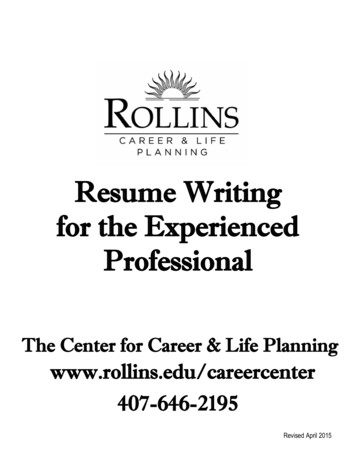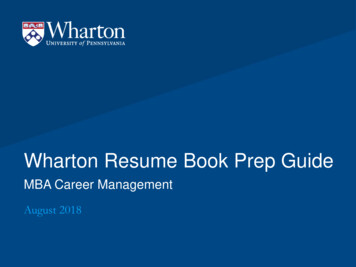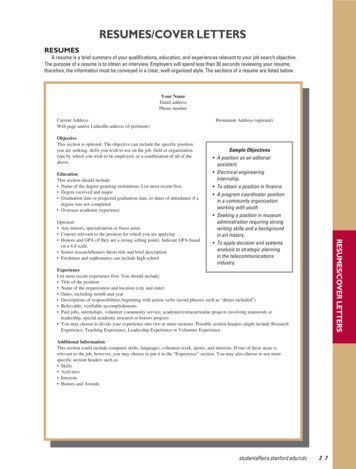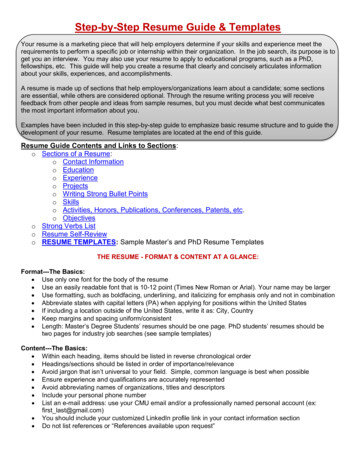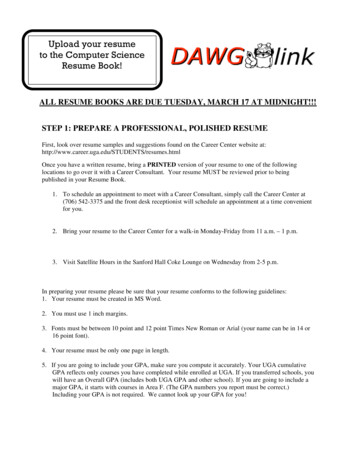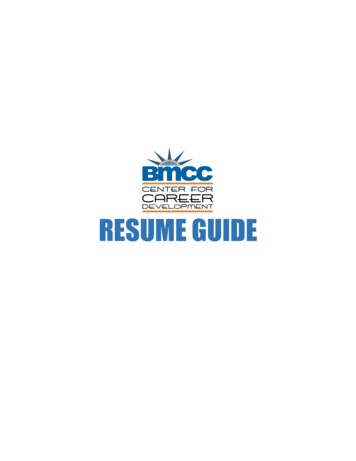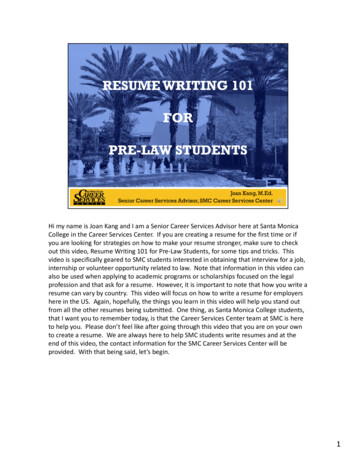
Transcription
RESUME WRITING 101FORPRE-LAW STUDENTSJoan Kang, M.Ed.Senior Career Services Advisor, SMC Career Services CenterHi my name is Joan Kang and I am a Senior Career Services Advisor here at Santa MonicaCollege in the Career Services Center. If you are creating a resume for the first time or ifyou are looking for strategies on how to make your resume stronger, make sure to checkout this video, Resume Writing 101 for Pre‐Law Students, for some tips and tricks. Thisvideo is specifically geared to SMC students interested in obtaining that interview for a job,internship or volunteer opportunity related to law. Note that information in this video canalso be used when applying to academic programs or scholarships focused on the legalprofession and that ask for a resume. However, it is important to note that how you write aresume can vary by country. This video will focus on how to write a resume for employershere in the US. Again, hopefully, the things you learn in this video will help you stand outfrom all the other resumes being submitted. One thing, as Santa Monica College students,that I want you to remember today, is that the Career Services Center team at SMC is hereto help you. Please don’t feel like after going through this video that you are on your ownto create a resume. We are always here to help SMC students write resumes and at theend of this video, the contact information for the SMC Career Services Center will beprovided. With that being said, let’s begin.1
Pop Quiz!What is the averageamount of time anemployer/recruiterstakes to review anapplicant’s resume?6 SECONDS!!!Let’s start off with a quick pop quiz? What is the average amount of time anemployer/recruiter takes to review an applicant’s resume?(Pause 10 seconds)Employers only spend about six seconds reading a resume. If you are lucky, even longer.2
Good News! There is more than one “right” way to write a resume!The good news is that there is no one “right” way or “magic” way to write a resume.However, there are some best practices and standards. Your job with your resume is tograb the viewer’s attention very quickly.3
Why Do You Need a Resume? A marketing tool To obtain an interview Requirement of many organizationsSo why do people need a resume? A resume is a marketing tool and not your professionalbiography. It is used to sell yourself to a potential employer or program so that you canobtain an interview. An effective resume will show how your qualifications match what anemployer is looking for in an ideal candidate. Therefore, it is important that your resumebe targeted to what job you are applying for. So, please, please always read the jobdescription. That means each resume you send out should also be different. You will learnmore about how to target your resume later in this video.4
Examples of Resumeswww.smc.edu/careerservicesBut first let’s look at a couple of resumes. As you can see on this slide, these resumes areall very different in style and content. You can find additional samples of resumes on theSMC Career Services Center website listed here.5
Resume-Hidden MessagesResumeYou Neat Neat Well-organized Well-organized Error free Attention to detail Careful & Competent ProfessionalappearanceAnd as I mentioned earlier in this video, there is no right way to write a resume. However, a resumecan say a lot about an applicant.Did you know that a resume can provide hidden messages to employers? A resume can tell a lotmore than the list of jobs you have had in the past. It can tell an employer what kind of applicantyou really are and on this slide, these are just a handful of examples of hidden messages yourresume may or may not already contain.For example, a neat, well‐organized and error free resume that is targeted directly to the jobposting and has been proofread carefully to catch any mistakes, shows that you are attentive todetail, understand grammar and spelling and competent for the job. Well‐formatted resumes thatflow naturally and share information that is relevant to the job description speaks volumes aboutyour ability to think and organize tasks. When an employer is looking to bring on board someone tomake their life easier on the job, these details matter. So make sure to have your resume reviewedby several individuals including the Career Services Center team at SMC.You are also told to make sure your resume looks professional. For practical reasons, a resume thatlooks professional is more important than looking creative. Thanks to technology, many employersuse ATS or Applicant Tracking Systems to weed out resumes that are not a close match for a job.These system can’t handle creative looking resumes.As I mentioned previously, and what I want to emphasize again, what you put on your resume willdepend on what is relevant to the job you are applying to; otherwise, what is stated on the jobdescription. On a resume, there are critical sections that you always need to include and there arealso optional sections that could go on your resume, depending on the information you havegathered from the job description and how your experience is relevant to that job description.Will talk about these sections in the next couple of slides.6
Layout and Format AestheticsContentLayout Length Font Size OrderBut first, let’s address the questions you have about what a resume is supposed to look like.Aesthetics: You need to craft a resume that is neat, easy to read and professional. Appearance matters! Be consistent infont choices, bullet points, text size, type of heading, all caps, dividing sections with lines, etc. These are ways to directthe viewer’s eyes to what is most important to see. Be intentional on what you use but make sure not to go overboard ornothing will stand out to the viewer’s eyes. For example, all your job titles should follow the same format. Again, avoidbeing too creative or flashy. You want an employer to be dazzled by your skills, knowledge and experience and notdistracted by images or a busy resume.Content: A resume is not an essay. You should only list the most relevant information, with the most importantinformation listed first. Never misrepresent yourself. It can come back to you. As I have also mentioned previously, it isessential to tailor your resume to the position you want. It needs to be well‐organized and 100% error free. Later in thisvideo, I’ll talk about items you should never include in your resume. However, remember that you can always ask tohave your resume reviewed by the Career Services Center team at SMC. Don’t rely on spell check.Layout: Start off with a blank Word document. Templates are usually not recommended because they may not allow youto easily move information, change bullet points, or text sizes. For online job applications or when sending your resumevia email or another electronic format, always save your resume as a PDF (Portable Document Format) Do not providedigital versions of your resume in Microsoft Word or Google Doc. Saving the file as a PDF, will preserve formatting.Length: Typically, because most of you have not had a lot of direct and relevant experience, being a student orrecent graduate, keep your resume to one page in length. Therefore, having smaller margins will allow you oneway to get more information on the page. You should have an appropriate amount of whitespace throughoutyour resume.Font size: Another way to fit more information on a page is to play with your font size. The font you use shouldbe easy to read. Avoid script fonts or fonts with too much design. The type size should between 10 and 12point.Order: Each section of your resume, should always follow a reverse chronological order, with the moreimportant information toward the top. Chronological means most recent information is listed first, followed byolder dates.7
The Heading What should be included? Name (First and Last) Address or thealternative Professional e-mailaddress Phone number withprofessional voicemailNow that you have an idea of what your resume will physically look like, let’s talk about some content, specifically, the heading. Yourresume header is the section that tops your resume. It is the first thing an employer or recruiter will check on your resume. It serves asa business card of sort. Having a poor resume header format can even mess with Applicant Tracking System (ATS) software used bymany hiring managers and therefore, can reject your resume. You should use the same header for your resume, cover letter, list ofreferences, etc.Resume headings carry all of your personal contact information. Therefore, it needs to include your first and last name and contactinformation, an employer can use to contact you. When posting your resume on the internet, consider whether or not you want yourresume to be public and how much of your contact information you want visible.First start off with your name. It is essential that your header include your name. It sounds obvious, but don’t forget it. The font typesize should stand out, be easy to read, but not look out of place. Make sure your name matches your resume, cover letter, onlineapplication materials, background check applications, etc.Typically, next would be to list your address. This is standard on resumes. However, as the landscape of communication changes, yourcomplete address is sensitive information that you should list on your resume if and when you feel comfortable. An alternative to listingyour entire physical address might be to just list the city and state where you reside.Next item to include is your email address. Chances are, this is how an employer will reach you. Make sure to list a professional emailthat you check often.Your phone number is the next most popular means of communication for employers. List a phone number with a voicemail set up toreceive messages. Make sure to use a professional outgoing message on your phone as well as be prepared to handle a professionalconversation when you answer your phone.Some of you might be thinking, should I include a link to my personal website, my social media handles or Linkedin information. Youshould only include this information if your accounts are current and up‐to‐date, relevant to the job and will enhance your chance ofobtaining an interview.Information that you need to leave out on your resume include items that personal such as your social security number(SSN), age, sex, height, weight, marital status, photograph, religion, race, color, national origin, date of birth, etc.8
Education Name of Institution Include city and stateName of your degree andmajor Associate in Arts, Public PolicyList degrees in reversechronological order Most recent degree is listedfirstDon’t forget you must complete a Petition to Graduate form to receivea degree/certificate at SMC. See Admissions and Records for moreinformation.Typically, after the heading, most current students and recent graduates should list theireducation first. This is because it is the most recent and relevant experience. Employerswant to see that you have earned your degree or potentially will be earning one. They cansee by the name of your degree /certificate, major and/or relevant coursework what areasyou have a foundation of knowledge.On your resume, include the name of the institution. Do not abbreviate the name of theschool. List the city and state where the institution is located and period of attendance orbetter yet, expected degree/certificate date information. Again, institutions need to belisted in reverse chronological order (most recent degree/certificate listed first). Check withan academic counselor at one of the several academic counseling programs to see if youqualify to receive a degree/certificate based on the coursework you have completed or willbe completing before you leave SMC. Make sure the dates are right aligned and thedegree/certificate is exactly what was issued or will be issued by SMC Admissions andRecords, the office where you submit your Petition to Graduate form. Employers do verifyinformation listed on your resume.9
Education Continued Date or expected dateof graduation Expected June 2020GPA (Optional) List if at least 3.25 orhigher Round down to thenearest tenth 3.0 not 3.062 GPA: 4.0, HighestHonorsIf you are anticipating receiving a degree, it is perfectly fine to use “Expected,”“Anticipated” or “To be Conferred” and the month and year you plan to receive it. Forexample, “Expected June 2020.”Some of you might be thinking, should I list my GPA. GPA is optional and should only beincluded if you have a 3.25 or higher GPA. Make sure to round down to the nearest tenthas seen in the example.10
Education Continued Additional optionalinformation: Study Abroad Relevant Coursework AcademicAwards/ScholarshipsIf space permits, other areas you could include that are optional are study abroad, relevantcoursework or academic awards, Dean’s List, honor societies, and merit‐based scholarships.Do not include your high school unless it is nationally recognized or you are applying for aposition at that school. If you are planning to include coursework, only list courses that arepertinent, especially if your major/degree do not relate to your employment goal.11
Experience What is consideredexperience? Full and part-time jobs Self-employment Volunteer work Internship/ServiceLearning experience Practicum, field, andcooperative education Leadership experience& more!Another key section of your resume is your experience. This section highlights your workexperience and should take up the bulk of your resume. This is the area that employersand law schools focus the most time reviewing. In this section, you can list paid and/orunpaid opportunities, part‐time and/or full‐time work, self‐employment experiences,internships, volunteer opportunities, significant leadership experiences, class projects,service‐learning experiences, and more.12
Experience Continued What are different waysto group yourexperiences? Legal Experience Academic Experience Professional WorkExperience Volunteer/LeadershipExperienceYour experience can be listed or group together in a variety of ways. For example, you can breakdown this section downinto smaller, more specific sections or be grouped together based on similarities. If you are limited in space, be sure tofocus on direct experiences that relate to the job description. That means you are choosing experiences that are relevantand tailored to the position you want. Typically, for entry level positions for undergraduates interested in the legalprofessions, this involves highlighting your ability to analyze/problem solve, manage your time, conduct research, writeand speak as well as your community involvement. Again, it is important to choose experiences that are relevant andtailored to the position you want. It is not required to list all of your experiences on your resume. These are just someexamples of how to group your experiences.Legal Experience: This is the area where you highlight any paid and unpaid internships, volunteer work in anylaw‐related work. You can also include any work performed as part of your educational experience that islaw‐related. For example, you should include your experiential learning experience in POL SCI 94 such as anyprojects you have completed and the areas in which you were working.Academic Experience: In this area, you should include any relevant class/research projects, field work,service‐learning experiences completed in other courses. You can also list any academicpresentations/publications.Professional Work Experience: Although employers and law schools might focus more on experiences directlyrelated to law, you could also include experiences obtained in other industries where you have accomplishedand gained skills that are transferable to the legal profession such as your ability to analyze/problem solve,manage your time, research or your strong written and communication skills.Volunteer/Leadership Experience: You can provide experiences where you volunteered for a day to extendedopportunities in which you helped communities or populations with a particular interest. You can alsohighlight the unparalleled leadership skills you learned as a student leader in a student club, sports programor other organization. For law schools especially, admissions committees are very interested in filling theirincoming classes with active and engaged students who will contribute to their student life.13
Experience Continued Information to include Job Title Start/end dates Company name City & StateUse bullet pointsStart with an action verb Vary your usage of verbs Present tense if currentlyemployed Past tense if no longeremployedNow, that you have an idea of what types of experiences to list in this section. How exactlydo you list it?You want to list the name of the companies you worked for, their location, dates ofemployment, meaning start and end dates, using month and year, the positions you heldand a brief description of the accomplishments and achievements you made in that role.Your experience is typically presented using bullet points and in reverse chronologicalorder, beginning with your current job and working back in time. Always start off eachbullet point under your experience section with an action verb. Make sure to use presenttense if the experience is current and past tense if the experience is no longer being done.You also want to use simple and professional looking bullets points which will make readingyour resume easier for employers.14
Experience Continued Tailor skills and experiences to the position for whichyou are applying (Don’t copy the job description)Be concise while providing enough detail (results,numbers, percentages)Don’t forgot about your transferable skills, projects,relevant courseworkRemove any use of personal pronouns or articles (“I”or “me”)When providing examples of your accomplishments and achievements, you want to tailoryour skills and experiences to the position you are applying to, but don’t copy the jobdescription. Be concise while providing enough details. Don’t just list tasks. Employers liketo see results, numbers, percentages versus generalities. Include how you solved problemsand achieved goals as well as other concrete and specific language.Resumes require a different kind of writing. It might seem counterintuitive but avoiding thefollowing resume slip‐ups will help ensure that you make the right impression. First, you want to avoid using professional jargon/technical language unless you areapplying for a job within that field. Second, avoid using clichés words or terms. Remember, you want to impress employersand not confuse them with jargon that is not familiar to them and overused words. Three, avoid using words such as “I,”, “my”, “we,” and other personal pronouns.Following these quick rules will help employers focus on the content of your resume andthat is really want matters most.15
Crafting Action-OrientatedAccomplishment Statements Construct statements that explain what you did in theposition, how you did it, and the results of your actions [Action Verb Example Result]Brainstorm gResearched SMC Corsair LawinsuranceFirm InternshiplawCourseProjects/ResearchCampus andCommunityInvolvementPOL SC 400So, let’s talk about how to construct those types of statements. You want to constructstatements that explain what you did in the position, how you did it and the results of youractions. First begin with an action verb to show you did something. Then include anexample or context for that action. Make sure to provide specific, clear and if possible,quantitative and qualitative terms. Finally demonstrate the result of your actions to showthe value of your work, the purpose and/or the impact.To help you connect your experiences and what is required in a job description as well ashow your experiences in one area translate into another, try this brainstorm activity.Step 1: Identify and list all the direct as well as transferable skills you possess in onecolumn.Step 2: Think about all the places in which you used or developed each of these skills andwrite them down under the appropriate column. Employment/Internships/Service‐Learning. Next column, Course Projects/Research. Finally, Campus and CommunityInvolvement. You may have listed a skill that you developed or used in one, two or three ofthe columns.Step 3: Bring it all together. Look at the job description and compare the skills that arebeing asked of a candidate with the skills you listed. Pull the relevant information and list iton your resume. That means adding an action verb to your example and listing the resultof what happened.16
List of Action dcomparedcompiledcompletedAction Verbs for Pre-Law/Law Pathway Program esidedscheduledsearchedTo help you identify what action verbs to use in your statements, here is a list of actionverbs. Action verbs make your resume stand out. They help paint a vivid description of aspecific experience, skill and/or accomplishment of yours. Spend time analyzing yourresume and determining the best action verb that you can use to properly convey who youare to an employer.17
Statement Examples Examples: Prepared and drafted 10 restraining orders basedon interviews with witnesses, victims and lawenforcement Assisted with fact development for litigation byinterviewing potential named plaintiffs Prepared a 6 to 10-page self-help guide forconsumers that explained immigration rights Researched insurance law to develop strategy forsettlement negotiations for client’s ADA and medicalclaimsHere are examples of how to properly convey who you are to an employer. These are someexamples of some accomplishment statements that contain an action verb, example and aresult. The statements reflect information that is listed on job descriptions.1.Prepared and drafted 10 restraining orders based on interviews withwitnesses, victims and law enforcement2.Assisted with fact development for litigation by interviewing potential namedplaintiffs3.Prepared a 6 to 10‐page self‐help guide for consumers that explainedimmigration rights4.Researched insurance law to develop strategy for settlement negotiations forclient’s ADA and medical claims18
Optional Sections ObjectiveSummarySkills Languages (List Proficiency Level). Computer Software Programs (avoid the obviousunless noted)As I mentioned earlier in my presentation, there are key sections of a resume and there are optional sectionsof a resume. We just covered the key elements of a resume. Let’s focus on some sections of a resume thatmay or may not be a part of one of you resumes.Objective: A well‐crafted objective signals to an employer that you are clear about the position you areseeking and the positions available with an employer. Objectives can also hinder your chances of obtainingan interview if you list an objective that does not match the position for which you are applying or if it doesn’tsupport the content of your resume. For most college students seeking an internship, experiential learningexperience or entry level job within the practice of law, you do not need state an objective on your resume.You also do not need to include an objective for law school applications. The objective for law school is selfexplanatory. You want to gain admissions to law school.Next, is a summary of qualifications. Again, this area is typically considered optional and reserved for thosewith more professional experience. The summary is the first piece of information an employer sees at thetop of your resume. It gives the resume reader a concise introduction to you, your expertise, industrybackground, training, etc. It is a way for you to briefly tie together your experiences and help employersunderstand how your varied experiences fit what they need. It is a brief opportunity for you to communicateyour experience, training and abilities as it pertains to the specific job.Finally, another optional element of a resume is the skills section. This is where you might list any knowledgeof a language and your proficiency level, technology‐based or computer skills, as well as other field‐specificskill sets and certifications related to the position. There is no need to list English on resumes foremployers in the US or random and unrelated hobbies. You also do not need to list the obvious softwareprograms such as Word and Excel unless noted in the job description. Skills should only include objective,measurable skills. Softer skills like communication, teamwork, or industry knowledge should be illustratedthrough your descriptions of your experiences.19
Need Additional Help?We are here to help you!Santa Monica CollegeCareer Services Centernd2 Floor, Student ServicesBuildingwww.smc.edu/careerservices(310) 434-4337careerservices@smc.eduNow that I have reviewed the purpose of a resume, the layout and format of one, as well asthe critical and optional sections of a resume, we at the Career Services Center at SMCwant you to know that we are here to help you on your path to success. Whether you needhelp with your resume, you haven’t decided on a major or career path or you know exactlywhere you want to end up, the Career Services Center is a great place to start as an SMCstudent. We offer a variety of resources and programs to help you explore your options orgain real‐word experience. Check out our website for more information or contact us byphone or email. Our contact information is listed on this page for your reference.20
The good news is that there is no one “right” way or “magic” way to write a resume. . via email or another electronic format, always save your resume as a PDF (Portable Document Format) Do not provide digital versions of your resume in Microsoft Word or Google Doc. Saving the file
